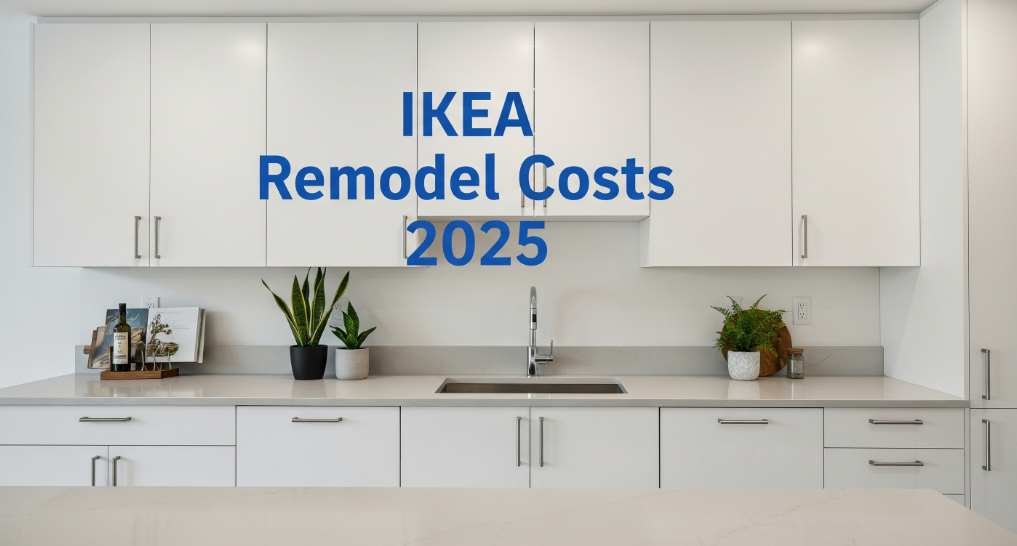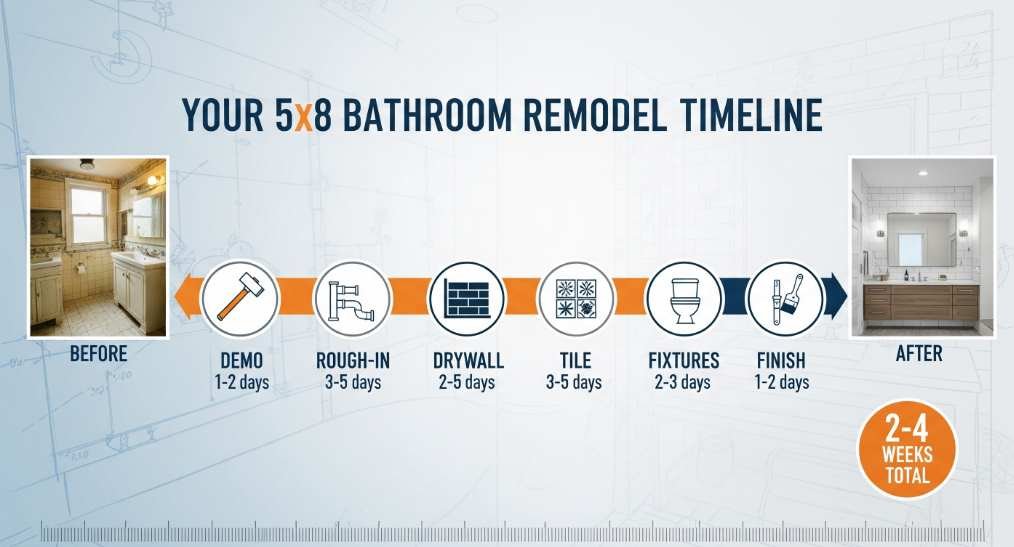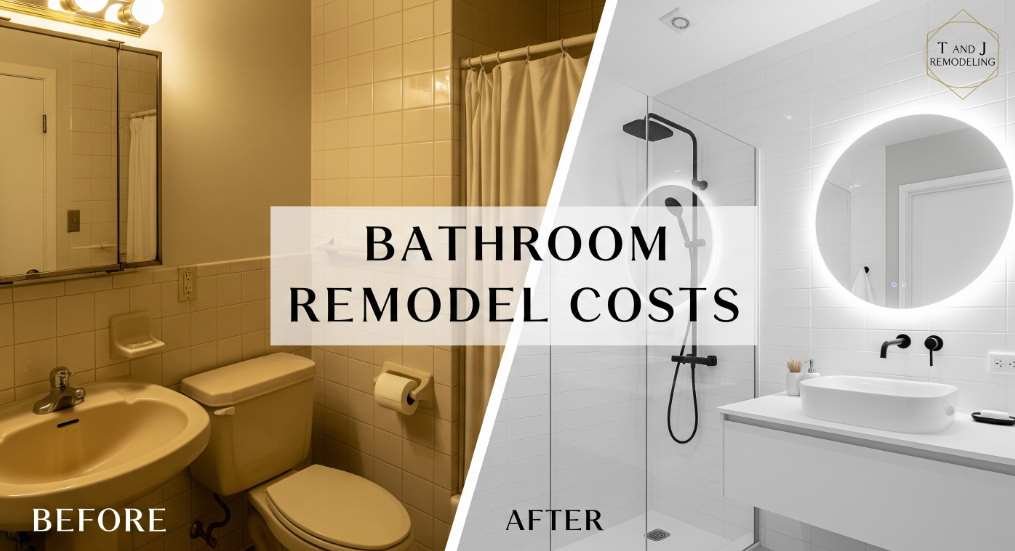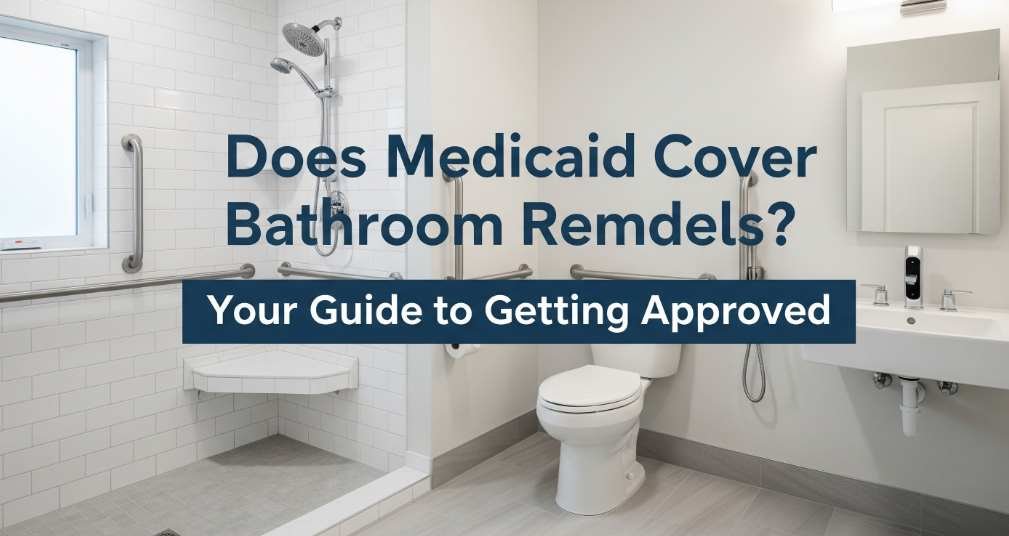Table of Contents
TogglePlanning a bathroom remodel and wondering if you need official approval? You’re asking the right question. Skipping required permits can cost you thousands in fines, create insurance headaches, and even prevent you from selling your home. The good news? Getting permits isn’t as complicated as you might think.
This guide tells you exactly when you need permits, how to get them, what they cost, and how to avoid expensive mistakes.
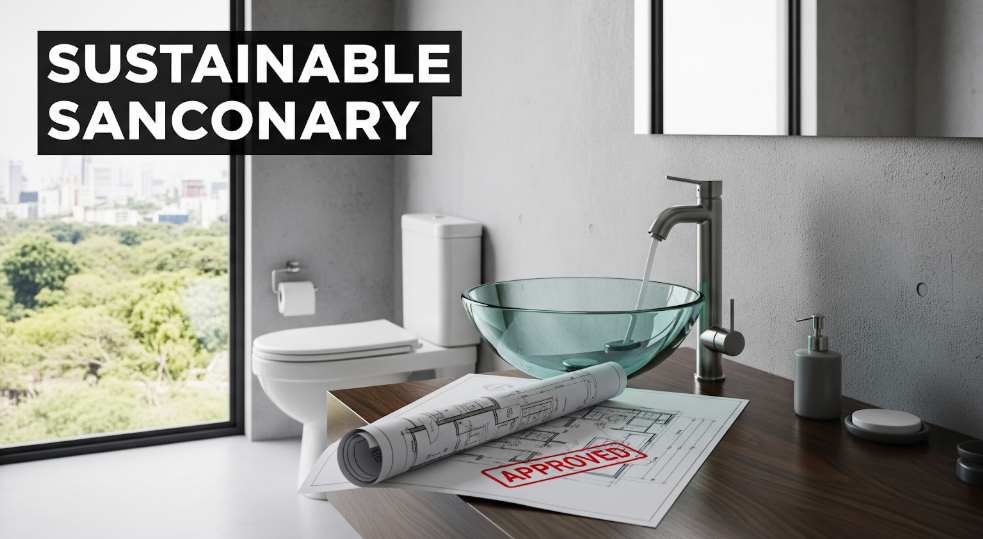
When Do You Need a Permit for Bathroom Remodeling?
Most bathroom remodels require permits when you make changes to plumbing, electrical, or structural components of your home. Think of permits as official approval that your work meets safety standards and building codes.
The simple rule: if you’re moving, adding, or changing anything behind the walls, you probably need a permit.
Work That Always Requires Permits
These bathroom projects always need official approval:
Plumbing changes: Moving your toilet, sink, or shower to a new location requires a plumbing permit. Even replacing old pipes with new ones needs approval because it affects your home’s water and drainage systems.
Electrical work: Adding new outlets, moving light fixtures, installing heated floors, or upgrading your electrical panel all require electrical permits. This protects you from fire hazards and ensures everything meets current electrical codes.
Structural modifications: Removing or moving walls, especially load-bearing walls, requires a building permit. Enlarging your bathroom by knocking down a wall or changing a doorway location also requires approval.
Ventilation systems: Installing new exhaust fans that vent outside typically requires permits. Proper ventilation prevents mold and moisture damage, so building departments want to verify it’s done correctly.
At T And J Remodeling, we’ve handled hundreds of permit applications for bathroom remodeling in Waukesha and surrounding areas. The most common projects requiring permits involve moving plumbing fixtures or adding new electrical circuits.
Work That Usually Doesn’t Need Permits
These cosmetic updates rarely require permits:
- Painting walls or cabinets
- Replacing cabinet doors or hardware
- Installing new flooring over existing floors
- Swapping out light fixtures in the same location
- Replacing a toilet, sink, or vanity in the same spot
- Updating faucets or showerheads
- Adding mirrors or shelving
- Replacing a bathtub with another tub of the same size in the same location
The keyword here is “replacing” items in their current locations without changing plumbing or electrical connections. Even simple cosmetic changes can dramatically improve your bathroom’s appearance without permit requirements.
However, local rules vary. What doesn’t need a permit in one city might require one in the next town. Always check with your local building department before starting work.
Why Building Permits Matter for Your Bathroom Project
Permits aren’t just bureaucratic paperwork. They protect you, your family, and your investment.
Safety first: Building inspectors check that electrical wiring won’t cause fires, plumbing won’t leak and damage your home, and structural changes won’t compromise your home’s integrity. These inspections catch problems before they become disasters.
Legal protection: Permitted work is documented in the public record. If something goes wrong years later, you have proof that the work was done properly and inspected. Without permits, you bear all liability for any issues.
Home value and resale: When you sell your home, buyers and their inspectors look for unpermitted work. Discovering unpermitted remodeling can kill a sale or force you to reduce your price significantly. Some buyers simply walk away rather than inherit potential permit problems.
Insurance coverage: Your homeowner’s insurance might deny claims related to unpermitted work. If a fire starts from unpermitted electrical work or water damage occurs from unpermitted plumbing, you could face massive out-of-pocket costs.
We’ve seen homeowners in New Berlin forced to tear out beautiful bathroom remodels because previous owners skipped permits. The cost of fixing unpermitted work always exceeds the original permit fees.
What Types of Permits Do Bathroom Remodels Need?
A single bathroom remodel often requires multiple permits. Understanding each type helps you budget accurately.
Building Permits
Building permits cover structural work and general construction. You need one when:
- Changing your bathroom’s footprint or size
- Moving or removing walls
- Adding or relocating windows
- Altering your home’s structure in any way
Building permits typically involve plan review, where officials examine your project drawings before approving work. This ensures your changes comply with local building codes and zoning requirements.
Plumbing Permits
Plumbing permits apply to water supply and drainage work. You need one for:
- Moving sinks, toilets, showers, or tubs
- Installing new plumbing fixtures in different locations
- Replacing old pipes or adding new water lines
- Changing drain locations or adding new drains
Plumbing inspectors verify that water pressure is adequate, drainage works properly, and all connections meet code. They check for proper venting to prevent sewer gases from entering your home.
Electrical Permits
Electrical permits cover power and lighting changes. You need one when:
- Adding new circuits or outlets
- Installing GFCI outlets (required in bathrooms)
- Moving light switches or fixtures to new locations
- Installing heated floors or towel warmers
- Upgrading your electrical panel capacity
Electrical inspectors ensure proper wire sizing, correct grounding, and safe installation methods. They verify GFCI protection for outlets near water sources, which prevents electrocution.
Similar to our approach with kitchen remodeling, bathroom projects often need all three permit types. A comprehensive remodel might require a building permit for moving a wall, a plumbing permit for relocating the shower, and an electrical permit for adding recessed lighting.
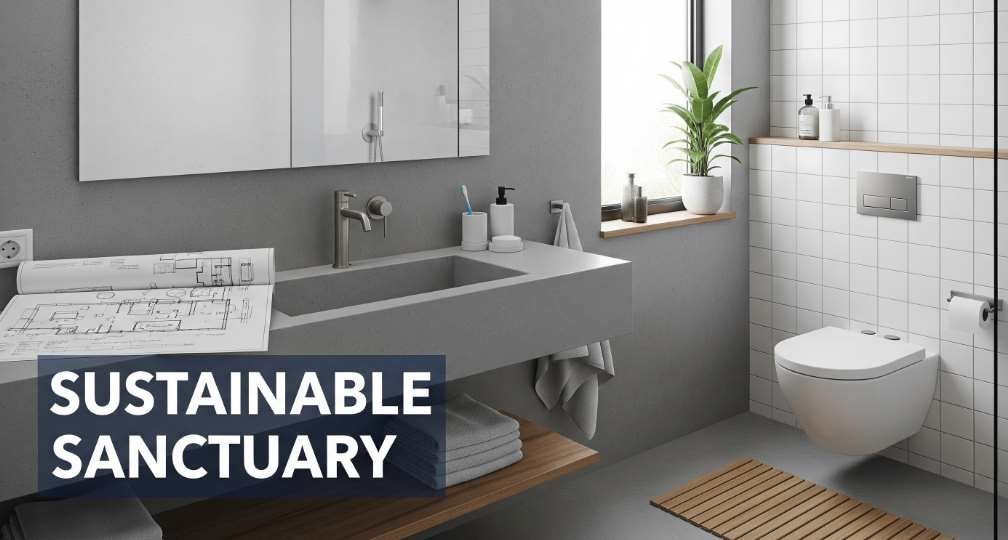
How Much Do Bathroom Remodel Permits Cost?
Permit costs typically range from $50 to $300 for individual plumbing or electrical permits, while full bathroom remodels involving multiple trades usually cost between $400 and $750 total in permits.
Here’s a typical breakdown:
Basic bathroom refresh (cosmetic only):
- No permits needed
- Permit cost: $0
Mid-range bathroom remodel (new fixtures, same locations):
- Plumbing permit: $75-$150
- Electrical permit: $50-$100
- Total permit cost: $125-$250
Major bathroom remodel (moving fixtures, structural changes):
- Building permit: $200-$500
- Plumbing permit: $100-$200
- Electrical permit: $75-$150
- HVAC permit (if adding/moving ventilation): $50-$100
- Total permit cost: $425-$950
Permit fees vary significantly by location. Major renovations involving structural changes or extensive plumbing modifications tend toward the higher end, with costs ranging from $200 to $2,000 depending on project scope and location.
Your city or county might charge based on project value (typically 1-2% of total costs) or use flat fees for specific work types. Some jurisdictions charge more for faster permit processing.
As experienced home remodeling contractors in Brookfield, we include all permit costs in our project estimates so you know exactly what to expect with no surprises.
Key takeaway: Permit costs represent roughly 1-3% of your total bathroom remodeling budget. Skipping them to save a few hundred dollars creates risks worth thousands.
How to Get a Permit for Your Bathroom Remodel
Getting permits is straightforward when you know the steps. Here’s exactly what to do:
Step 1: Contact your local building department. Find your city or county building department online or by phone. Ask what permits your specific project requires. Describe your planned work in detail—they’ll tell you which permits you need.
Step 2: Prepare required documents. Most bathroom permits require:
- Detailed project description
- Property survey or site plan
- Bathroom floor plan showing existing and proposed layouts
- Plumbing and electrical diagrams
- Product specifications for major fixtures
- Contractor license information (if using a contractor)
Professional contractors typically prepare these documents. If you’re DIYing, the building department can guide you on what they need.
Step 3: Submit your application. Complete permit applications online or in person at your building department. Include all required documents and pay application fees. Many jurisdictions now offer online applications that speed up the process.
Step 4: Wait for plan review and approval. The building department reviews your plans to ensure code compliance. This takes anywhere from a few days to several weeks, depending on project complexity and department workload. They might request changes or additional information.
Step 5: Receive your permit. Once approved, you’ll receive physical permits to post at your job site. These show inspectors that the work is officially approved.
Step 6: Schedule required inspections. As work progresses, call for inspections at required stages:
- Rough-in inspection (before covering walls)
- Final inspection (after completion)
Inspectors check work at each stage and either approve it or note corrections needed. Never cover work before inspection—you might have to tear it out for the inspector to see.
Step 7: Receive final approval. After passing all inspections, you receive final approval. This officially closes the permit and documents that the work meets all codes.
At our remodeling services in New Berlin, we handle the entire permit process for our clients. It’s one less headache for homeowners to worry about.
What Happens If You Skip the Permit?
Skipping permits is an easy way to save time and money. It’s not. The consequences can be severe and expensive.
Fines and Penalties
Getting caught doing unpermitted work can result in stop-work orders, significant fines, and delays in selling your property. Building departments have the authority to:
- Issue stop-work orders halting your project immediately
- Levy fines ranging from hundreds to thousands of dollars
- Require you to apply for permits retroactively (at higher “after-the-fact” fees)
- Demand you tear out completed work so inspectors can see what’s behind the walls
- Force you to bring old work up to current code standards
After-the-fact permits typically cost double or triple standard permit fees. In extreme cases, you pay tens of thousands to correct unpermitted work.
Insurance Issues
Your homeowner’s insurance policy likely requires permitted work for major renovations. If unpermitted electrical work causes a fire or unpermitted plumbing causes water damage, your insurance company can deny your claim.
You’d be personally liable for all damage costs, potentially destroying your finances. The few hundred dollars saved by skipping permits pales compared to hundreds of thousands in uninsured damage.
Problems Selling Your Home
Smart buyers and their home inspectors look for unpermitted work. When they find it, several things happen:
- The sale might fall through completely
- Buyers demand significant price reductions
- You’re required to obtain permits before closing (delaying the sale)
- You must restore the bathroom to its pre-remodel condition
- Legal liability issues cloud the transaction
Title companies sometimes refuse to insure properties with known unpermitted work. Without title insurance, most buyers walk away.
We’ve worked with homeowners who inherited unpermitted bathroom remodels. Fixing these situations costs more than doing it right the first time. One Waukesha client spent $8,000 correcting a previous owner’s $15,000 unpermitted bathroom remodel—essentially paying twice for the same bathroom.
Common Permit Mistakes Homeowners Make
Avoid these frequent errors that cause permit problems:
Mistake 1: Assuming small projects don’t need permits. Even minor plumbing or electrical changes often require permits. Moving a light switch six inches to the left technically needs an electrical permit in most jurisdictions.
Mistake 2: Starting work before permit approval. Never begin construction before receiving official permit approval. Starting early can result in stop-work orders, fines, or requirements to undo completed work.
Mistake 3: Skipping required inspection. Some homeowners get permits but skip inspections, thinking they’ll pass. Inspectors catch real problems. Skipping inspections means potentially dangerous work stays hidden until it causes serious issues.
Mistake 4: Covering work before inspection. Don’t close walls or install finished surfaces before the rough-in inspection. Inspectors need to see plumbing pipes, electrical wiring, and structural work. If you cover it prematurely, they’ll make you tear it out.
Mistake 5: Hiring unlicensed contractors. Unlicensed contractors often skip permits to hide their lack of credentials. They do substandard work that fails inspections. Always verify contractor licenses before hiring.
Mistake 6: Believing “everyone skips permits.” Just because your neighbor renovated without permits doesn’t make it smart or legal. Building departments actively look for unpermitted work through aerial photos, tax assessor visits, and neighbor reports.
Who Pulls the Permit: You or Your Contractor?
Generally, licensed contractors pull permits for work they perform. This makes sense because:
- Contractors know what permits are required
- They understand local code requirements
- They’re familiar with the application process
- Their license is on the line if work fails inspection
- Professional liability protects you
However, homeowners can pull permits for DIY work in most jurisdictions. You’ll need to:
- Prove you own the property
- Demonstrate basic knowledge of relevant codes
- Take responsibility for all work quality and safety
- Be available for all required inspections
Permits pulled by homeowners often face more scrutiny because inspectors know you’re not a professional. They might require additional documentation or inspections.
When hiring a professional for your bathroom remodel, confirm they’ll handle all permitting. This should be clearly stated in your contract. Reputable contractors like T and J Remodeling include permit services in their project scope.
Red flag: If a contractor suggests skipping permits to “save money” or “speed things up,” walk away. They’re either unlicensed or do shoddy work, or both.
How Long Does the Permit Process Take?
Timeline varies by location and project complexity, but here are typical timeframes:
Simple permits (single-trade, straightforward work):
- Application to approval: 3-10 business days
- Total from application to final inspection: 2-4 weeks
Complex permits (multiple trades, structural changes):
- Application to approval: 2-6 weeks
- Plan review and revisions: 1-3 weeks
- Total from application to final inspection: 6-12 weeks
Factors affecting the timeline include:
- Building department workload and staffing
- Project complexity and required reviews
- Application completeness and accuracy
- Inspector availability in your area
- Time of year (spring and summer are busiest)
Pro tip: Submit permit applications well before you want to start work. Don’t schedule contractors or order materials until permits are approved. Unexpected delays in permit approval can derail your entire project schedule.
In the greater Milwaukee area, including Waukesha, Brookfield, and New Berlin, we typically see permit approval within 2-3 weeks for standard bathroom remodels. Structural changes or significant plumbing relocations might take longer.
Making Your Bathroom Remodel Permit-Ready
Set yourself up for permit success with these preparations:
Document your current bathroom: Take detailed photos and measurements of existing conditions. This helps with permit applications and provides before-and-after evidence.
Create a clear project plan: Outline exactly what you’re changing. Be specific about fixture locations, new electrical outlets, lighting plans, and structural modifications.
Know your local codes: Research basic requirements for your area. Common issues include:
- Minimum ceiling height requirements
- Required distances between fixtures
- Ventilation requirements
- GFCI outlet regulations
- Proper waterproofing standards
Budget for permits: Include permit costs, inspection fees, and potential plan revision expenses in your budget. Don’t let permit expenses surprise you.
Choose licensed professionals: Work with licensed plumbers, electricians, and contractors who know local codes and handle permits regularly.
Plan for inspection timing: Build inspection schedules into your project timeline. Don’t rush to cover work before inspections happen.
Starting with permits in mind makes the entire process smoother and keeps your remodel on track.
FAQ: Do You Need a Permit for Bathroom Remodel
Do I need a permit for a cosmetic bathroom remodel?
No, cosmetic changes like painting or new tiles usually don’t require a permit, as they don’t affect structure or systems.
What happens if I remodel my bathroom without a permit?
You could face fines up to $5,000, forced redo of work, or issues selling your home, plus safety risks.
How long does it take to get a bathroom remodel permit?
It typically takes 1-2 weeks for approval after submission, depending on your local department.
Do I need a permit to add a bathroom?
Yes, adding a bathroom involves plumbing and electrical, so a permit is required in most areas.
Who pulls the permit for a bathroom remodel?
The contractor usually pulls it, but homeowners can too; pros like T And J ensure it’s done right.

